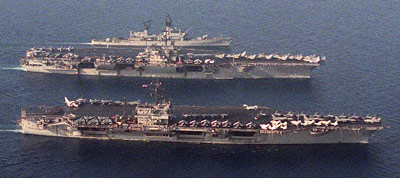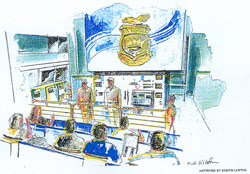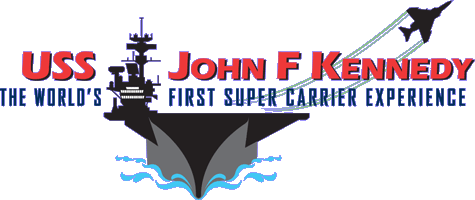
[clear]
The Navy’s November, 2009 decision to make JFK available for donation put the USS Saratoga Museum Foundation into a box. There is only room for one aircraft carrier attraction in New England, and if some other group were able to put forth a viable application (especially for a site such as Boston), the Saratoga effort in Rhode Island would have certainly been doomed.
After much internal discussion, the Saratoga board agreed that the worst case scenario would be if a third party, not beholden in any way to the Saratoga cause, was awarded the JFK.
Seeing the handwriting on the wall, the Saratoga board saw the need to align itself with a group that could compete for the JFK in order to protect the large investment of volunteer hours, cash and in-kind donations that have been made over the past 12 years.
The Saratoga board voted to support a JFK application being prepared by Rhode Island Aviation Hall of Fame, Inc. That corporation had been in existence for nine years, and its annual induction event boasted a long and prominent list of sponsors and supporters.
That decision was a prudent one.
On April 2, 2010, citing concerns about the ship’s deteriorating condition, the Secretary of the Navy notified Congress that the Navy has removed the ex-SARATOGA (CV 60) from donation status. Plans have been put in motion to scrap the ship instead of making it available as a public attraction, thus ending the non-profit effort to reactivate Saratoga as a family attraction in Rhode Island.
 Despite the many years of work focused on Sara, it is difficult to argue with the Navy’s logic. Saratoga was decommissioned 16 years ago, has been only minimally maintained, and has been stripped to provide equipment for other ships in the fleet.
Despite the many years of work focused on Sara, it is difficult to argue with the Navy’s logic. Saratoga was decommissioned 16 years ago, has been only minimally maintained, and has been stripped to provide equipment for other ships in the fleet.
On the other hand, JFK is in mobilization readiness condition. The upfront capital cost would be millions of dollars less. More importantly from the Navy’s perspective, the ongoing maintenance cost would be less, and the need to dry dock JFK again would be decades further into the future.
Adding the intangible value of the name (especially in southern New England) creates an attractive package that would undoubtedly be easier to promote to donors and corporate sponsors.
From a purely business perspective, JFK is simply a more attractive option, with a higher chance for eventual success.
That is small consolation for those with an emotional attachment to Sara. However, the Navy letter confirming the plan to scrap Saratoga recognized all the time, effort and money that has been invested in the Saratoga project.
“The Navy sincerely appreciates your interest in obtaining the ex-SARATOGA for use as a museum/memorial for public display. We also acknowledge the years of volunteer work and expense that has gone into this initiative, and are prepared to work with you to recognize that effort.”
In acknowledgment of the value of the Saratoga Foundation’s support of the JFK effort, RIAHOF has agreed to allocate significant space in the hangar bay of “Big John” to honor the memory of all US Navy ships named Saratoga, along with the men who served in them. The USS Saratoga Museum Foundation, Inc. has already asked the Navy to assist with this transition (and to help soften the blow caused by the decision to scrap Saratoga.)
The Saratoga Foundation has asked to preserve historical Saratoga assets for possible future display aboard JFK, and even the potential removal of a meaningful piece of the superstructure before the ship leaves Newport. The Navy has confirmed its support of the preservation of Saratoga artifacts for that purpose.
Here is what such an exhibit could look like.
Saratoga Legacy Hall:
At the heart of the displays and exhibits visitors will step back in time, beyond the stark realism of the Gulf War to the early days of our country’s history when the fledgling US Navy commissioned the first of six ships to proudly bear the name USS Saratoga. This Hall will showcase the remarkable family tree of the fighting Saratogas; six generations of naval vessels that helped shape our nation’s history, starting in 1780. Five of the six Saratogas saw battle, and many had links to Rhode Island.
One special exhibit will honor the first aircraft carrier named Saratoga (designated CV-3) and all who lived and died aboard her from 1928 to 1946. Visitors will enter this time warp by walking down Main Street, USA through an extremely realistic three-dimensional “Home Front” exhibit, showing the day-to-day life and times of America at War in 1944.
The last storefront on Main Street will be the US Navy Recruiting Office. After passing through those doors, the snapshot in time takes one to the Pacific War. World War II aircraft will be displayed in realistic, diorama-like environments.
Woven into the story of the six Saratogas will be additional “Home Front” exhibits, showing how Americans lived in 1780, 1814, 1846, 1865, 1888, 1917, 1944 and 1961 – epochal dates in the history of warships named Saratoga.
[totop] to Top [/totop]
